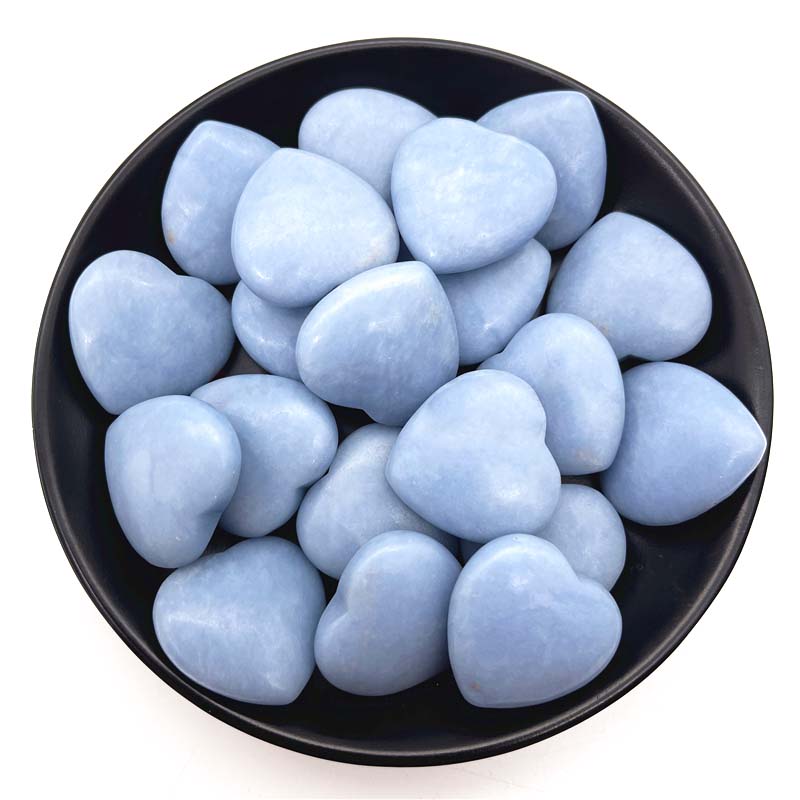To understand the Angelite stone, let’s first understand what anhydrite is.
What is anhydrite?
Although gypsum and anhydrite are different minerals, they can be mistaken for the same kind by name.
Because they are one of the main minerals constituting the accumulation of rock, they are formed by evaporation of seawater and grow together in rock salt caves.
Although the output of anhydrite is less than that of gypsum, as long as the water is added to the deposit, it will slowly decompose into gypsum.
There are few clear crystals in the appearance of anhydrite. Although most of them are massive, they can be broken into small pieces of cubes due to good cleavage. Calcite used to be this kind of ore in China.
Gypsum is also formed around volcanic fumaroles. According to its appearance, it can be divided into three types: single transparent crystal permeable gypsum (Selenite), fibrous aggregate fibre gypsum (SatinSpar), and microcrystal aggregate(Alabaster).
Gypsum contains crystal water. Once the temperature exceeds 70 ℃, part of the crystal water will be released to form hemihydrate gypsum.
If the temperature exceeds 200 ℃, it will be entirely dehydrated for become anhydrite; If heated to 300 ℃, it will become white powder gypsum.
Once water is added to the powder, it will heat up and solidify. It was the ancient Romans who discovered this phenomenon. They used gypsum as a building material, while modern people used this property to make use of medical gypsum shed belts or take molds.
Although the composition of anhydrite is similar to gypsum, it belongs to other minerals in structure. The chemical formula is the same series as barite and celestite.
Although they are closely related, anhydrite is not hard gypsum. Anhydrite is also called anhydrite because it does not contain water in its structure.
The powder formed after it is heated will not solidify like gypsum, even if water is added.
In addition to being mixed into lime as a drying agent as a building material, it can also be used as a raw material for cement, paint, fertilizer, etc.
What is Angelite Stone?

Angelite stone is mainly produced in Peru, belonging to the anhydrite family. Although it is not hard and can not become a high-priced gem, the appearance of sky blue with gray makes people feel warm, so it is also popular.
In the new era of natural therapy, this is a kind of ore that can call for the help of Angelites.
Basic Properties of Angelite Stone
Color: blue, grey blue
Hardness: 3~3.5
Cleavage: complete cleavage
Crystallization system: orthorhombic system
Main origin: Peru, the United States and the United Kingdom
Appearance characteristics of Angelite Stone
Angelite stone comes from the anhydrite family. The difference between anhydrite and gypsum is that the former does not contain water, so please do not place the Angelite Stone in a place with heavy moisture, which may cause structural damage.
The blue color of Angelite Stone comes from strontium (Sr), which is widely found in mineral water or mountain springs and can prevent arteriosclerosis. It is an essential element for modern people.
The healing meaning of Angelite stone crystal
Angelite stone belongs to the rhombic crystal system and is a natural healer. It can help us repair wounds, maintain energy stability and calm emotions.
For people with autistic tendencies, Angelite Stone can provide some help and bring a sense of peace and tranquillity. The lithium element contained in the Angelite Stone is a metal element with extremely high radiation energy, which can help smooth blood vessels. It can also keep the energy in the open state so that people can continue to connect with higher energy.
How to use Angelite Stone
People can wear the Angelite Stone with them. Sometimes we will get the favour and help from unknown forces that the Angelite Stone can provide this energy.
At the spiritual level, there may be a sense of closeness that people do not want to talk about or do not want to talk about. At this time, you can use Angelite Stone to heal wounds and bring new energy.
When is it good to use Angelite Stone?
Focus on praying
The body is hot and the mood is unstable
When I feel lost
When looking for the direction of life
How to clean Angelite Stone?
Purification mode
√: Aromatic smoke, crystal hole, sound
×:Sea salt and flowing water methods will cause mineral erosion, and the sunlight method will fade.
Conclusion:
Angeliteite belongs to the rhombic crystal system, which is produced in Peru. Angeliteite is a natural healer. It can help us repair wounds, maintain energy stability and calm down emotions. For people with autistic tendencies, the Angelite Stone can provide some help, bringing a sense of peace and tranquillity.
The strontium element contained in the Angelite Stone is a metal element with extremely high radiation energy, which can help smooth blood vessels.
It can also keep the energy in an open state and let people continue to connect with higher energy, just like Angelites bless us.
